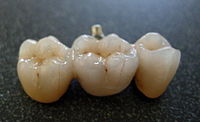
Photo from wikipedia
This study uses fracture tests and fractographical analysis to compare computer-aided design and computer-aided manufacturing (CAD/CAM) lithium disilicate molar crowns with the previous occlusal thickness recommendation of 1.5-mm, the new… Click to show full abstract
This study uses fracture tests and fractographical analysis to compare computer-aided design and computer-aided manufacturing (CAD/CAM) lithium disilicate molar crowns with the previous occlusal thickness recommendation of 1.5-mm, the new recommendation of 1.0-mm, and a less invasive thickness of 0.8-mm. After fatigue application, fracture tests and fractographic analysis were conducted. The fracture resistance of CAD/CAM lithium disilicate molar crowns was different depending on the occlusal thickness of the restoration, and decreased with lower the thickness. However, the fracture resistance of crowns of all three thicknesses exceeded the reported maximum bite force in the first molar region after the fatigue process, and can be considered acceptable for use in the clinic.
Journal Title: Dental materials journal
Year Published: 2022
Link to full text (if available)
Share on Social Media: Sign Up to like & get
recommendations!